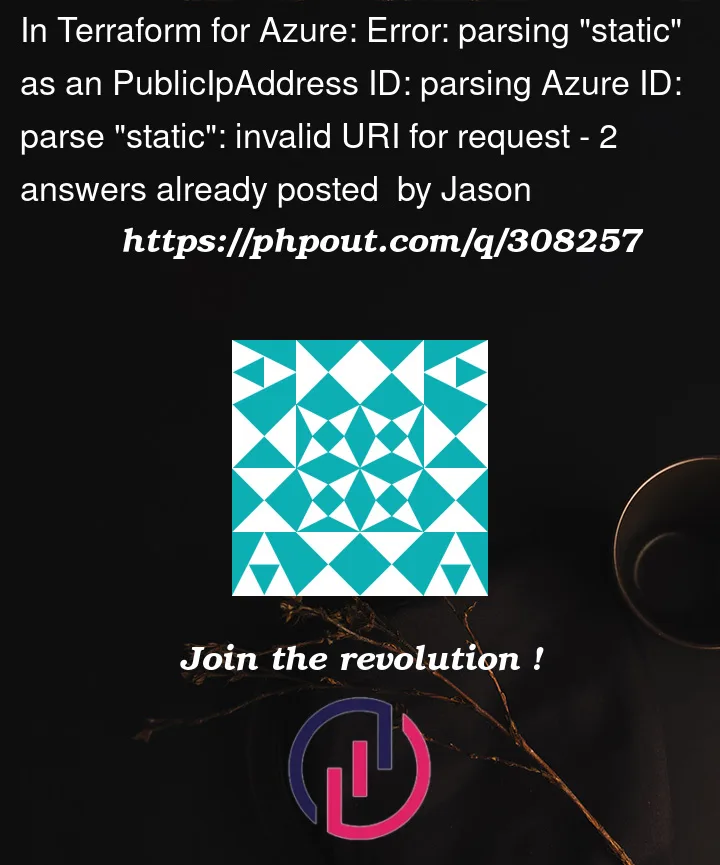I’m building a basic template for an Azure Public Load Balancer and I’m running into the above error when running Terraform Validate. Can anyone tell me what I’m missing? Below is what I have so far. Appreciate the help in advance!
Before trying to build a public facing load balancer, I successfully built an internal Azure Load Balancer without any issues. I’ve also referenced the Hashicorp website and modified as needed while building the config.
"Full error:
Error: parsing "static" as an PublicIpAddress ID: parsing Azure ID: parse "static": invalid URI for request
with azurerm_lb.PLB,on mainPLB.tf line 76, in resource "azurerm_lb" "PLB": 76: public_ip_address_id = "static"
terraform {
required_providers {
azurerm = {
source = "hashicorp/azurerm"
version = "3.85.0"
}
}
}
provider "azurerm" {
features {}
}
resource "azurerm_resource_group" "Change_me_RG" {
name = "Change_me_RG"
location = "East US"
}
resource "azurerm_virtual_network" "change_me_network" {
name = "change_me_network"
location = azurerm_resource_group.Change_me_RG.location
resource_group_name = azurerm_resource_group.Change_me_RG.name
address_space = ["10.0.0.0/16"]
depends_on = [azurerm_resource_group.Change_me_RG]
}
resource "azurerm_subnet" "SubnetA" {
name = "SubnetA"
resource_group_name = azurerm_resource_group.Change_me_RG.name
virtual_network_name = azurerm_virtual_network.change_me_network.name
address_prefixes = ["10.0.0.0/24"]
depends_on = [azurerm_virtual_network.change_me_network]
}
resource "azurerm_network_security_group" "Inbound_NSG" {
name = "Inbound_NSG"
location = azurerm_resource_group.Change_me_RG.location
resource_group_name = azurerm_resource_group.Change_me_RG.name
#Rule to allow traffic on port 80
security_rule {
name = "test123"
priority = 200
direction = "Inbound"
access = "Allow"
protocol = "Tcp"
source_port_range = "*"
destination_port_range = "80"
source_address_prefix = "*"
destination_address_prefix = "*"
}
}
resource "azurerm_subnet_network_security_group_association" "NSG_Association" {
subnet_id = azurerm_subnet.SubnetA.id
network_security_group_id = azurerm_network_security_group.Inbound_NSG.id
depends_on = [azurerm_network_security_group.Inbound_NSG]
}
resource "azurerm_public_ip" "PLB_ip" {
name = "PLB_ip"
location = azurerm_resource_group.Change_me_RG.location
resource_group_name = azurerm_resource_group.Change_me_RG.name
allocation_method = "static"
sku = "Standard"
}
resource "azurerm_lb" "PLB" {
name = "PLB"
location = azurerm_resource_group.Change_me_RG.location
resource_group_name = azurerm_resource_group.Change_me_RG.name
frontend_ip_configuration {
name = "frontend-ip"
public_ip_address_id = azurerm_public_ip.PLB_ip.id
}
sku = "Standard"
depends_on = [azurerm_public_ip.PLB_ip]
}
resource "azurerm_lb_rule" "RuleA" {
loadbalancer_id = azurerm_lb.PLB.id
name = "RuleA"
protocol = "Tcp"
frontend_port = 80
backend_port = 80
frontend_ip_configuration_name = azurerm_lb.PLB.frontend_ip_configuration[0].name
backend_address_pool_ids = [azurerm_lb_backend_address_pool.PoolA]
probe_id = azurerm_lb_probe.ProbeA.id
depends_on = [azurerm_lb.PLB]
}
resource "azurerm_lb_backend_address_pool" "PoolA" {
loadbalancer_id = azurerm_lb.PLB.id
name = "BackEndAddressPool"
depends_on = [azurerm_lb.PLB]
}
#appvm1 from VM network interface
resource "azurerm_lb_backend_address_pool_address" "appvm1_address" {
name = "example"
backend_address_pool_id = azurerm_lb_backend_address_pool.PoolA.id
virtual_network_id = azurerm_virtual_network.change_me_network.id
ip_address = "10.0.0.1"
#ip_address = azurerm_network_interface.example_interface.private_ip_address
depends_on = [azurerm_lb_backend_address_pool.PoolA]
}
#appvm2 from VM network interface
resource "azurerm_lb_backend_address_pool_address" "appvm2_address" {
name = "example"
backend_address_pool_id = azurerm_lb_backend_address_pool.PoolA.id
virtual_network_id = azurerm_virtual_network.change_me_network.id
ip_address = "10.0.0.2"
#ip_address = azurerm_network_interface.example_interface.private_ip_address
depends_on = [azurerm_lb_backend_address_pool.PoolA]
}
resource "azurerm_lb_probe" "ProbeA" {
loadbalancer_id = azurerm_lb.PLB.id
name = "ProbeA"
port = 80
depends_on = [azurerm_lb.PLB]
}
#backend address pool makes the frontend traffic (port 80) go to port 80 in the backend pool
resource "azurerm_lb_rule" "RuleA" {
loadbalancer_id = azurerm_lb.PLB.id
name = "RuleA"
protocol = "Tcp"
frontend_port = 80
backend_port = 80
frontend_ip_configuration_name = "PublicIPAddress"
backend_address_pool_ids = [azurerm_lb_backend_address_pool.PoolA.id]
probe_id = azurerm_lb_probe.ProbeA
depends_on = [azurerm_lb.PLB, azurerm_lb_probe.ProbeA]
}




2
Answers
@Marcin & @Thomas Thank you for guiding in the right direction with your valuable inputs.
The error you are encountering in your Terraform configuration for an Azure Public Load Balancer seems to be related to an incorrect reference for the
public_ip_address_idin theazurerm_lbresource definition. The error message indicates that Terraform is expecting an Azure resource ID, but it’s receiving a literal string"static"instead.This will create confusion for Terraform in the way you’re referencing the public IP address in your load balancer configuration.
My Directory Structure:
This structure is more simple and user-friendly.
My terraform configuration:
main.tf:
modules/network/main.tf:modules/security/main.tfmodules/load_balancer/main.tfOutput:
the value your passing is in small letter static
these are the expected values for parameter allocation_method – (Required) Defines the allocation method for this IP address. Possible values are Static or Dynamic.
you cannot parse static use Static for the above configuration.